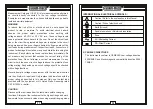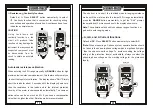
®
®
15
16
4) OPERATION
Before and after hazardous voltage measurements, test the
voltage function on a known source such as line voltage to
determine proper meter functioning.
CAUTION
mV function defaults at DC. Press
SELECT
button momentarily
to select AC. Press the Hz push-button momentarily to activate
or to exit Hz.
DC Voltage, AC Voltage, & Hz Frequency functions
Note: Input sensitivity varies automatically with function range
selected before activating the Hz function. mV function has the
highest (300mV) and the 1000V range has the lowest (300V). It is
recommended to first measure the signal voltage (or current) level
Crest Factor
Crest Factor is the ratio of the Crest (instantaneous peak) value
to the True RMS value, and is commonly used to define the
dynamic range of a True RMS DMM. A pure sinusoidal waveform
has a Crest Factor of 1.4. A badly distorted sinusoidal waveform
normally has a much higher Crest Factor.
NMRR is the DMM's ability to reject unwanted AC noise effect that
can cause inaccurate DC measurements. NMRR is typically
specified in terms of dB (decibel). This series has a NMRR
specification of >60dB at 50 and 60Hz, which means a good ability
to reject the effect of AC noise in DC measurements.
Common mode voltage is voltage present on both the COM and
VOLTAGE input terminals of a DMM, with respect to ground.
CMRR is the DMM's ability to reject common mode voltage effect
that can cause digit rolling or offset in voltage measurements.
This series has a CMRR specifications of >60dB at DC to 60Hz in
ACV function; and >120dB at DC, 50 and 60Hz in DCV function. If
neither NMRR nor CMRR specification is specified, a DMM's
performance will be uncertain.
NMRR (Normal Mode Rejection Ratio)
CMRR (Common Mode Rejection Ratio)

































